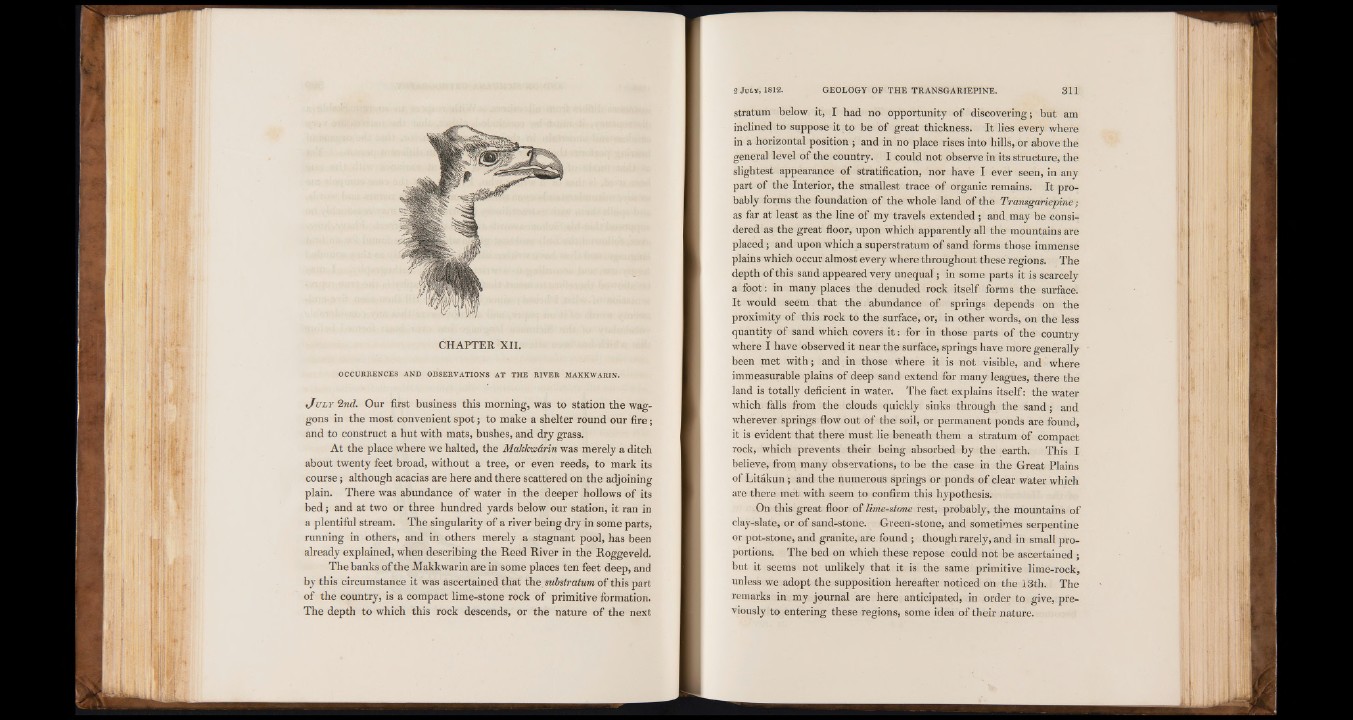
CHAPTER XII.
OCCURRENCES A N D OBSERVATIONS AT TH E RIVER MAKKWARIN.
J u l y 2nd. Our first business this morning, was to station the waggons
in the most convenient spot; to make a shelter round our fire;
and to construct a hut with mats, bushes, and dry grass.
At the place where we halted, the Makkwarin was merely a ditch
about twenty feet broad, without a tree, or even reeds, to mark its
course; although acacias are here and there scattered on the adjoining
plain. There was abundance of water in the deeper hollows of its
bed; and at two or three hundred yards below our station, it ran in
a plentiful stream. The singularity of a river being dry in some parts,
running in others, and in others merely a stagnant pool, has been
already explained, when describing the Reed River in the Roggeveld.
The banks of the Makkwarin are in some places ten feet deep, and
by this circumstance it was ascertained that the substratum of this part
of the country, is a compact lime-stone rock of primitive formation.
The depth to which this rock descends, or the nature of the next
stratum below it, I had no opportunity of discovering; but am
inclined to suppose it to be of great thickness. It lies every where
in a horizontal position ; and in no place rises into hills, or above the
general level of the country. I could not observe in its structure, the
slightest appearance of stratification, nor have I ever seen, in any
part of the Interior, the smallest trace of organic remains. It probably
forms the foundation of the whole land of the Transgariepine;
as far at least as the line of my travels extended; and may be considered
as the great floor, upon which apparently all the mountains are
placed; and upon which a superstratum of sand forms those immense
plains which occur almost every where throughout these regions. The
depth of this sand appeared very unequal; in some parts it is scarcely
a foot: in many places the denuded rock itself forms the surface.
It would seem that the abundance of springs depends on the
proximity of this rock to the surface, or, in other words, on the less
quantity of sand which covers it: for in those parts of the country
where I have observed it near the surface, springs have more generally
been met with; and in those where it is not visible, and where
immeasurable plains of deep sand extend for many leagues, there the
land is totally deficient in water. The fact explains itself: the water
which falls from the clouds quickly sinks through the sand; and
wherever springs flow out of the soil, or permanent ponds are found,
it is evident that there must lie beneath them a stratum of compact
rock, which prevents their being absorbed by the earth. This I
believe, from many observations, to be the case in the Great Plains
of Litakun; and the numerous springs or ponds of clear water which
are there met with seem to confirm this hypothesis.
On this great floor of lime-stone rest, probably, the mountains of
clay-slate, or of sand-stone. Green-stone, and sometimes serpentine
or pot-stone, and granite, are found ; though rarely, and in small proportions.
The bed on which these repose could not be ascertained ;
but it seems not unlikely that it is the same primitive lime-rock,
unless we adopt the supposition hereafter noticed on the 13th. The
remarks in my journal are here anticipated, in order to give, previously
to entering these regions, some idea of their nature.